Francis Darwin's annotated copy of the Origin of Species (1859)
 This rare presentation copy of the Origin of species belonged to Darwin's third son Francis Darwin (1848-1925). And, as first revealed here, it once belonged to Charles Darwin himself. It is now part of a private collection in Virginia, USA. We are very grateful to the owner for having it scanned and allowing the images to be published in Darwin Online.
This rare presentation copy of the Origin of species belonged to Darwin's third son Francis Darwin (1848-1925). And, as first revealed here, it once belonged to Charles Darwin himself. It is now part of a private collection in Virginia, USA. We are very grateful to the owner for having it scanned and allowing the images to be published in Darwin Online.
The Origin of species, one of the most influential books ever written, was published on 24 November 1859. 1,250 copies of the first edition were printed. (See Freeman intro) The number that survive today is not yet known, but our Darwin Census is conducting a detailed survey. At least twenty-three presentation copies of the first edition are known to exist of c.90 originally sent. None are signed by Darwin himself.
 The verso of the front free endpaper of this copy is inscribed 'From the Author' by a clerk at the publisher John Murray. The recto is inscribed 'F Darwin Cambridge'.
The verso of the front free endpaper of this copy is inscribed 'From the Author' by a clerk at the publisher John Murray. The recto is inscribed 'F Darwin Cambridge'.
The upper right corner of the title page is marked with Darwin family shelf-marks in pencil. The number '92' corresponds to the number given in the 1875 'Catalogue of the Library of Charles Darwin' CUL-DAR240, p. 108, which demonstrates that this copy originally belonged to Charles Darwin. The title page also has what may be earlier catalogue numbers "S. 9 36". The 'S' probably stood for 'Study'.
Francis was eleven years old when the Origin of species was published. As it is signed by him 'Cambridge' this may date from his time as a student at Trinity College, Cambridge (1866-1870). Between 1874-1882 Francis assisted his father's researches at Down. From 1888 to 1904 Francis was Reader in Botany at Cambridge so he could also have signed the book then.
 Francis made over 250 pencil annotations in this copy on more than 215 of its pages. Most are marginal lines, underlinings and other marks. There are also editorial comments. On page 8 Francis wrote 'Weismann' next to a passage on variations and monstrosities. This was apparently a reference to August Weismann's theory of the germ plasm, a later theory that denied that acquired characteristics of body cells, as opposed to reproductive cells (eggs and sperm), could be inherited.
Francis made over 250 pencil annotations in this copy on more than 215 of its pages. Most are marginal lines, underlinings and other marks. There are also editorial comments. On page 8 Francis wrote 'Weismann' next to a passage on variations and monstrosities. This was apparently a reference to August Weismann's theory of the germ plasm, a later theory that denied that acquired characteristics of body cells, as opposed to reproductive cells (eggs and sperm), could be inherited.
On page 440 the line: 'No one will suppose that the stripes on the whelp of a lion, or the spots on the young blackbird, are of any use to these animals, or are related to the conditions to which they are exposed.' is marked as 'deleted in the vi edition', (i.e. the 6th edition of the Origin of species) which was published in 1872. On one of the back endpapers Francis made a note 'cumulative action of N S 43', N S = natural selection.
After his father's death in 1882, Francis published revised editions of some of his father's works. Francis is best known for his pioneering three volume biography of his father: The life and letters of Charles Darwin (1887) and later works. The writing and publication of the Origin of species is described in Life and letters, vol. 2, pp. 126-178. See Robert Brown's introduction to Francis's draft of 'Reminiscences of My Father's Everyday Life'. Hundreds of documents pertaining to Francis are preserved in the Darwin Archive at Cambridge University Library and many can be viewed in Darwin Online here.
Images of this entire copy of the Origin of species can be viewed here, or downloadable PDF (170MB).
To view only the pages annotated by Francis, a second copy, omitting all unannotated pages, is provided here and PDF (67MB).
John van Wyhe
November 2009
RN4







